Tomatoes are quite a useful fruit. It’s a staple for salads and it also makes a great sauce for pasta and other meals. Interestingly, they are also easy to grow – and some of their smaller varieties can even be grown inside your home.
To ensure successful growth, you will start with a large pot at least 18 inches in diameter. Then, you have to plant the seeds on a well-draining soil mix to support the growth of the tomato plant’s roots. While waiting for it to grow, place the pot somewhere where it can receive bright direct sunlight for at least six hours.
In this article, you will be given a step-by-step guide on how to successfully grow your tomatoes indoors.
After you’re done with reading, you’ll also learn which tomato variety can best be grown indoors, when it’s best to grow your tomatoes, and how to take care of your growing plant. Continue reading to learn all about these topics and more.
Can You Grow Tomatoes Indoors?
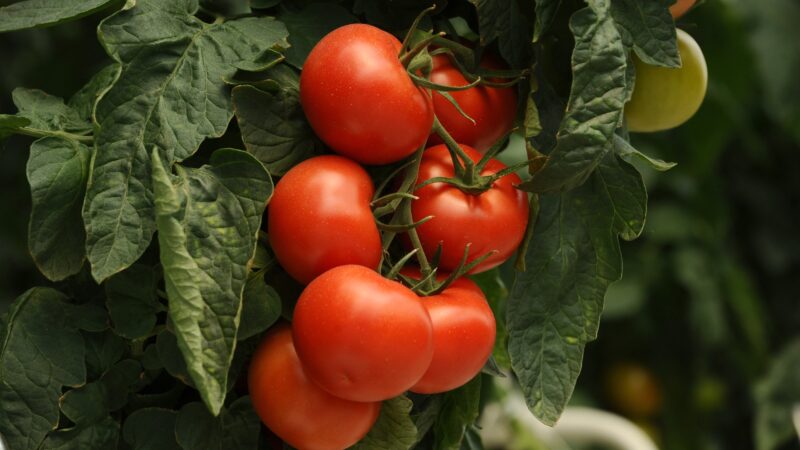
It is possible to grow tomatoes indoors. Bear in mind that tomatoes need direct sunlight exposure for at least six hours and a warm temperature ranging between 65 to 75 degrees Fahrenheit.
They also need one to two inches of water every week to keep them from becoming dehydrated. As long as you can mimic its ideal growing environment, then you can successfully grow your tomatoes indoors.
Why Grow Tomatoes Indoors?
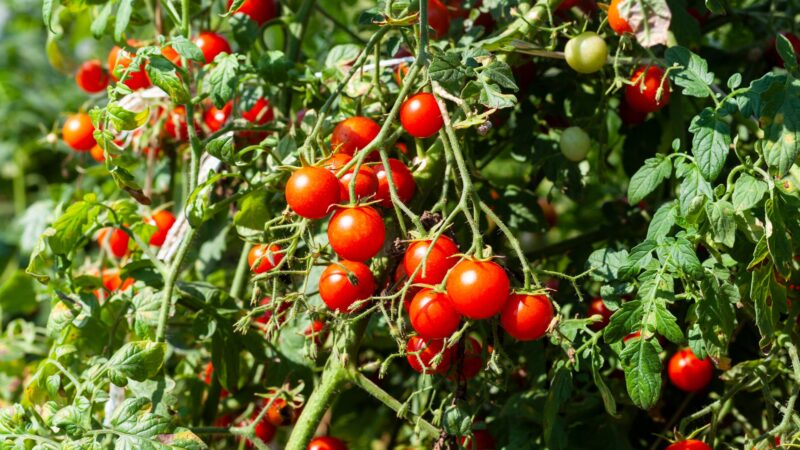
There are several reasons why you should grow your tomatoes indoors. Here are some of them:
- It protects the tomato plant from extreme weather changes. There are times when the weather just seems unpredictable. In this case, the temperatures are not stable enough to ensure the healthy growth of your plant.
- Tomatoes continue to grow even during the winter. Tomatoes thrive when it’s warm. So when the temperatures drop during the winter, your tomato plants may become damaged or die. Thus, planting them indoors allows you to keep them warm throughout the freezing winters.
- The surrounding conditions are easier to control indoors. When you plant your tomatoes indoors, you can easily adjust the room temperature and humidity levels to what’s ideal for your plant. This is in contrast to growing your plant in the garden, where it is exposed to various environmental elements.
- It adds color to your home. Tomato plants have beautiful thick foliage, long vines, and beautiful red-orange clusters of fruits. With that said, there’s no denying that growing tomatoes indoors also has a decorative purpose.
Best Tomato Varieties to Grow Indoors
When it comes to growing tomato varieties indoors, the key is to find those that do not need a lot of space to thrive. While the tomato plant is considered an annual vine that needs a lot of space, there are several varieties that grow in an upright manner. That allows you to make the most of the vertical space in your home to grow these tomatoes.
Thus, when it comes to growing tomatoes indoors, the best option is the dwarf varieties that produce cherry tomatoes. The best varieties that have adapted to indoor growing include the following:
- Micro Tom Tomatoes. The Micro Tom tomato plant is among the smallest tomato varieties out there. Its plant grows only up to eight inches tall, and it bears fruits that are less than an inch in diameter. Interestingly, the Micro Tom is quite disease-resistant, making it a hardy plant to grow at home.
- Siam Tomatoes. The Siam tomato plant is another plant that you can grow indoors. It matures in less than three months, so you can expect a harvest sooner than other varieties. However, you may need more space for this variety since it grows up to 18 inches tall and spreads up to 12 inches.
- Red Robin Tomatoes. If you’re looking for cherry tomatoes that grow larger fruit than the others, the Red Robin is perfect for you. Aside from producing a large cluster of fruits, its cherry tomatoes can also grow up to 1.5 inches in diameter – as opposed to others that only grow up to 0.5 inches in diameter.
- Sweet ‘n’ Neat Scarlet Tomatoes. As its name implies, the Sweet ‘n’ Tasty Neat Scarlet tomato variety is best known for its 1-inch sweet fruit. Interestingly, it only grows up to 12 inches tall, so it doesn’t require a lot of space at home.
When to Plant Tomato Seeds Indoors?
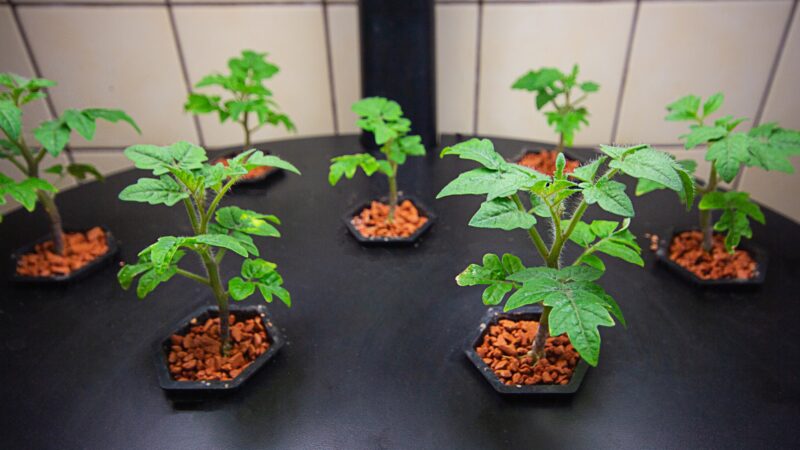
The schedule to plant tomato seeds outside usually fall during March and April, when it’s warm and sunny outside. However, tomato seeds can be planted at any time indoors.
Since you’re planning to sow them indoors, then it doesn’t matter when you’ll be planting them. While indoors, you can always create an atmosphere that’s similar to the late spring to early summer environment for your tomato plant.
Can Tomato Plants Survive Winter Indoors?
Tomato plants can survive the winter indoors. Tomatoes thrive when it’s hot and humid, so the cold and dry winters will cause more harm than good.
Fortunately, you can easily control the temperature and humidity settings indoors to help your tomato plant last through the winter.
How Long Will a Tomato Plant Produce Indoors?
How long an indoor tomato plant will start to produce its fruits largely depends on the variety you have planted. Fast producers like the Siam tomato plant can give you fruits as early as two months, while other varieties will start bearing fruit at four months.
Of course, this is assuming that you give your plant the right amount of lighting, water, and environment to support the growth of its fruits.
How Long Can a Tomato Plant Live Indoors?
An indoor tomato plant can live between two to five years. This is assuming that it is always under ideal living conditions, kept safe from pests and diseases, and is always given enough water and sunlight.
Where to Grow Your Tomato Plants Indoors?
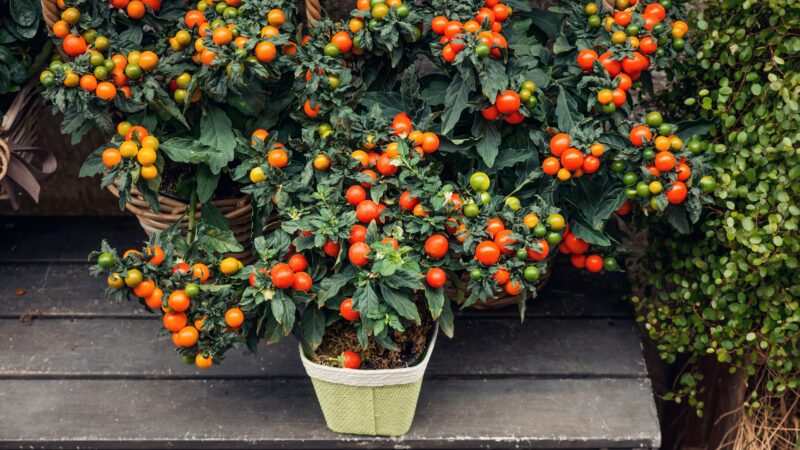
The ideal location for growing your indoor tomato plant is somewhere where it can get good air circulation, heat, and sunlight. This may either be near the window or by a screen door – especially during the spring and summer seasons.
Once the temperature drops, you may opt to move it to a room where you can control the temperature and humidity levels while still giving it access to light.
Can You Grow Tomatoes Indoors With Grow Lights?
You can grow tomatoes indoors with grow lights. Grow lights provide plants with artificial light that mimics that of the sun. This artificial lighting not only provides them with sunlight but also makes the area warm, which is ideal for growing tomatoes. This makes growing light useful during the fall and winter months.
However, it must be noted that while tomatoes need only six to eight hours of direct sunlight, they may need around 12 to 16 hours of grow-light exposure per day.
How to Grow Tomatoes Indoors? | A Step-by-Step Guide
Step 1: Start by identifying which tomato variety you want to plant indoors. As earlier discussed, cherry tomatoes are the best option in this case.
Step 2: Once you have your tomato seeds, simply place them in a pot that’s filled with well-draining soil. You can start with a 6-inch nursery pot like these BangQiao Nursery and Seedling Pots.
- Made of premium thicker plastic PP material, vertical flat sides...
- The durable small starter pots can be stackable for storage...
- Feature swirl shape drainage design on the bottom for optimal...
- BangQiao plastic deep pot is perfect for the plants with a long...
- Package includes 10pcs plastic nursery plant pots with size in...
Step 3: For best results, you can add potting mix with the soil. The Miracle-Gro Seed Starting Potting Mix ensures healthy root development and strengthens them to prevent root rot.
- Specially formulated for fast root development
- Enriched with Miracle-Gro Plant Food
- Excellent for starting cuttings
- Use when starting from seed and with leaf, stem or root cuttings
- This bundle includes two 8 qt. bags of Miracle-Gro Seed Starting...
Step 4: Then, mist the soil until it is moist. Do so daily to ensure that the soil stays moist. At this stage, tomato seeds do not need lighting yet.
Step 5: In a month or so, the seeds will already sprout roots and a tiny plant. Once the plant reaches four inches, it is time to transfer it to a bigger pot. In transferring, make sure to do so carefully so no damage is done to its roots.
Step 6: Once the plant is transferred to a new pot, you should also transfer it to a place where it gets six to eight hours of direct sunlight. Alternatively, make sure to put it under a Grow Light for 12 to 16 hours per day.
Step 7: After a few weeks, the tomato plant will start to grow vines. At this time, it is necessary to place stakes around it to ensure the vertical growth of your tomato plant. These Natural Garden Bamboo Sticks are an eco-friendly alternative to plastic or metal plant stakes.
- Premium Quality - The Bamboo sticks are all hand made and made of...
- Natural Material - Natural Bamboo material makes it very...
- Widely Uses - It’s available for indoor and outdoor plants such...
- Perfect for plants growing - This garden bamboo poles is a...
- Package - 20pcs 18 inches natural bamboo sticks & 1 pack ties. If...
Step 8: At this point, you should only give your tomato plant about one to two inches of water per week.
Just continue watering your plant, giving it adequate light, and make sure that the temperature doesn’t drop below 70 degrees Fahrenheit. In a few more weeks, the tomato fruits will be ready for harvest – and you can plant more tomatoes from its seeds.
How to Take Care of Tomatoes Indoors?
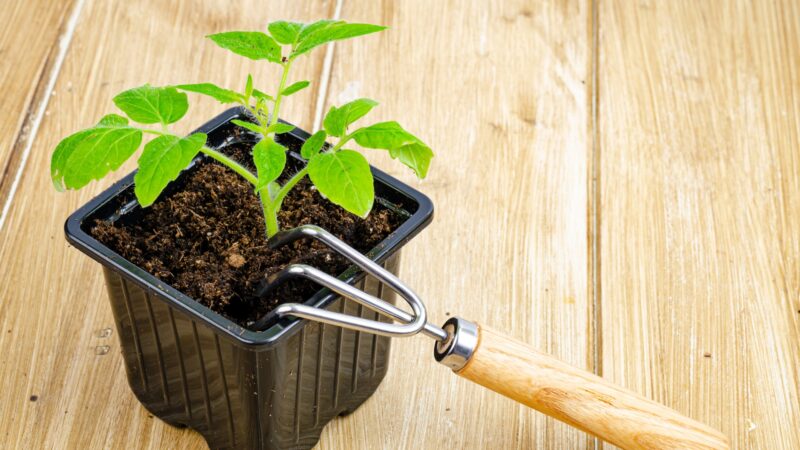
Lighting
Tomatoes thrive under direct sunlight. To help them produce juicy fruits, they should be exposed to the sun for around six to eight hours per day.
With that said, indoor tomatoes may get that amount of sunlight if they are placed near the window. This allows them to bask under the sun and get their much-needed vitamin D. However, this is feasible only during the spring and summer months.
When the temperatures drop during the fall, it is best to provide your indoor tomato with artificial light. A good option to consider is these full-spectrum Grow Light Bulbs that mimic the brightness and heat offered by the sun.
- Full Spectrum & Natural Light: A19 full spectrum grow light...
- High Brightness & Energy Saving: A19 LED plant grow light bulbs...
- Higher Efficiency: LED grow bulb with high light transmission...
- Longer Lifespan: LED sun light bulbs with low heat generated,...
- Natural Home Light Color: Unlike those purple or reddish grow...
Water
All plants need water to survive. Aside from keeping them hydrated, water also helps the roots absorb the nutrients from the soil. With that said, make sure your indoor tomato plant gets about one to two inches of water per week.
However, if you notice that the soil is already dry even before its scheduled watering, you can already sprinkle it with water. This ensures that it will not wilt or become dehydrated.
Temperature and Humidity
Tomatoes love warm and humid places. To make sure that your tomato plant will thrive indoors, the key is to maintain a temperature of 70 to 85 degrees Fahrenheit and humidity levels ranging between 65 to 85%.
Soil
The ideal soil for growing tomatoes indoors is well-draining. This allows the water to easily drain through the pot while keeping the sand moist.
This also prevents the roots from becoming soaked in water – which is the usual culprit for root rot. Thus, make sure to use sandy loam or any well-draining alternative when it comes to planting your tomatoes.
Pot size
Even though the ideal tomatoes for indoor growth are those under the dwarf varieties, it is worth noting that you still have to plant them in a large pot. Your tomato plant will need something that’s at least 12 inches deep, especially since tomatoes are known for their strong and extensive root systems.
A deep pot will also allow you to place a tomato stake deep enough to provide support for your plant. These Fabric Plant Pots are not only well-draining but also offer a 20-inch depth for your tomato’s root system.
- 5-Pack 15 Gallon Plant Grow Bags, Size: 50cm*30cm (D20"x H12")...
- Well-made Fabric Plant Pots, Rip-Resistant and No-Shrinking Plant...
- Multi-Purpose Garden Plant Grow Bags, 7-size Select Garden...
- Light-weight, Reusable Garden Fabric Pots, Aeration Root Pots;...
- Multi-Size Select, More Choice, Thickened and Sturdy, Versatile...
Fertilizer
Tomatoes need fertilizer to abundantly produce fruits. That’s why it’s best to feed your plant with fertilizer before it produces fruit.
With that said, you only need to feed them fertilizer once a week. The Miracle-Gro Tomato Plant Food is specially formulated for growing tomatoes, making it a good option to consider.
- Instantly feeds to grow bigger, more bountiful vegetables versus....
- Feed every 1-2 weeks
- Great for tomatoes and vegetables
- Use with Miracle-Gro Garden Feeder or any watering can
- Safe for all plants, guaranteed not to burn when used as directed
Potting and Repotting
Tomatoes need to be repotted once in a while, especially when they have outgrown their current pot. The first repotting takes place once the seeds have sprouted and have grown a 4-inch plant.
The succeeding times to re-pot would be once the plant has grown to three times the size of its container.
In transferring your tomato plant to its new pot, make sure to do so carefully so as not to cause any damage to its root system. Otherwise, it might experience transplant shock and wilt as a result.
How to Prune Tomato Plants Indoor?
Like all plants, whether indoor or outdoor, pruning is necessary to ensure its healthy growth. Indoor tomatoes are no exception.
The reason why tomatoes need pruning is because of the growth of small shoots. Otherwise known as suckers, these are tiny growths that appear like slim branches that do not produce any fruit. They can be found between stems and branches.
Suckers are so named because they tend to suck the energy and nutrients from the plant without contributing anything. This is akin to the tomato plant wasting energy that could have been used to produce more fruits.
Fortunately, it is easy to prune an indoor tomato plant. Here are the steps to ensure successful pruning:
- Identify the suckers on the plant.
- With your bare hands, simply pinch twist, and pull the sucker out of the tomato plant. In the case of a thicker shoot, you may opt to remove it with a pair of garden shears like these Yieldcropper Pruning Shears. Just make sure that it is sterile before doing so to prevent infecting your plant.
- REDUCE HAND STRESS: We know that pruning for long periods of time...
- PROFESSIONAL DESIGN: Not only is our pruners durable and...
- PERFECT FOR ALL TYPES OF GARDENING: These extra durable pruning...
- A MORE PRECISE CUT: Whether you are pruning your standard stems...
- YIELDCROPPER QUALITY PROMISE: Don't waste you time on poorly made...
- Look for signs of yellowing or wilting on your plant.
- If there are yellow or wilting leaves, it is best to cut them off, as well from the branches. This will allow your tomato plant to focus its energy on growing its healthy parts.
Are There Pests and Diseases That Affect Indoor Tomatoes?
Plants are usually at the bottom of the food chain, and indoor tomatoes are no exception. Pests are especially attracted to the juicy tomato fruit, as well as to the sap on the plant’s stem and leaves. That makes the tomato a favored choice among pests.
As such, you have to be prepared to deal with pests and disease-causing pests to keep your tomato healthy. The following are the usual pests that feast on indoor tomatoes:
- Aphids. Aphids are a common pest and are known to wreak havoc on various plants. They love the juicy sap on tomato fruits and leaves, so it doesn’t take long for an aphid infestation to occur. If you notice a cluster of tiny green, brown, or black bugs on its leaves, coupled with a growth of mold, then your tomato plant has an aphid infestation.
- Spider mites. Another common pest that threatens indoor tomatoes is spider mites. Unfortunately, these pests are almost microscopic, so it’s hard to tell when there’s an infestation until it’s too late. Usual symptoms include wounds on leaves that appear like tiny white holes.
- Whiteflies. As its name implies, whiteflies are tiny white-winged flies that feed on and lay their eggs on tomatoes. They are responsible for causing the leaves to wilt, especially since they often suck the juice out of each leaf.
Fortunately, it’s easy to get rid of all of these pests. Neem oil is known to repel these pests and prevent them from coming back. Thus, spraying neem oil like the Natria 706250A Neem Oil Spray for Plants on your tomato will keep these pests away.
No products found.
Frequently Asked Questions
Is It Better to Grow Tomatoes Indoors or Outdoors?
It is still best to grow tomatoes outdoors. In the outdoors, your tomato plant can freely spread its vines and bask in the direct heat of the sunlight. This allows them to grow larger fruits for your consumption.
Also, tomatoes that are exposed to natural sunlight are known to be juicier than those that grew under artificial or indirect indoor lighting.
Do I Need to Pollinate My Indoor Tomato Plants?
There is no need to pollinate your indoor tomato plants. Interestingly, tomatoes are complete plants that are capable of self-pollination. This means that a plant contains both male and female parts that are necessary for reproduction.
However, there are times when it needs help in releasing its pollen. In this case, you may opt to provide them with an electric fan to mimic the outdoor wind and spread the pollen. Another option is to give your tomato plant a light shake to release the pollen.
Can I Propagate Tomatoes Myself?
You can propagate tomatoes by yourself. Propagation is the process of multiplying a plant species using a part of an existing plant. With tomatoes, it is possible to propagate the plant through tomato fruit slices and stem cuttings.
The key to successful propagation is to make sure that the environment surrounding your plant is conducive to its healthy growth. Also, make sure to water it regularly and monitor the new plant to prevent diseases and pest infestations.
Why Is My Indoor Tomato Plant Wilting?
There are several reasons why tomato plants wilt. The usual culprits are the following:
- The plant is not given enough water.
- The plant is given too much water.
- It has been exposed to sunlight, indirect or artificial, for extended periods.
- It is not receiving enough light.
- There is a fungal infection or disease.
- There is a pest infestation.
Sources
Solanum lycopersicum ‘Micro-Tom’ – https://www.nparks.gov.sg
Tomato Insect Pests – https://hgic.clemson.edu
Growing Vegetables: Tomatoes [Fact Sheet] – https://extension.unh.edu
Growing Tomatoes in the Home Garden – https://ohioline.osu.edu






